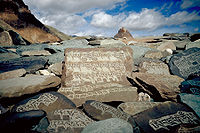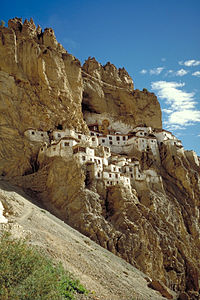Zanskar
Zanskar is a region in the Kargil district, part of the north-west Indian state of Jammu and Kashmir. The administrative centre is Padum. Zanskar, together with the neighbouring region of Ladakh, formerly belonged to Guge or Western Tibet.








Geography
Zanskar covers an area of some 7,000 square kilometres (2,700 square miles), at a height of between 3,500 and 7,000 metres (11,500–23,000 feet). It consists of the country lying along the two main branches of the Zanskar river. The first, the Doda, has its source near the Pensi-La (4,400 metres) (14,450 feet) mountain-pass, and then flows south-eastwards along the main valley leading towards Padum, the capital of Zanskar. The second branch is formed by two main tributaries known as Kurgiakh-chu, with its source near the Shingo-La, and Tsarap-chu, with its source near the Baralacha-La. These two rivers unite below the village of Purne to form the Lungnak river (also named Lingti or Tsarap). The Lungnak-Chu then flows north-westwards along a narrow and precipitous gorge towards the Padum Valley, where it unites with the Doda river to form the Zanskar river.
The Zanskar river then takes a north-eastern course until it joins the Indus river in Ladakh. High mountain ridges lie on both sides of the Doda and Lingti–Kurgiakh valleys, which run north-west to south-east. To the south-west is the Great Himalayan Range which separates Zanskar from the Kisthwar and Chamba basins. To the north-east lies the Zanskar Range, which separates Zanskar from Ladakh. The only outlet for the whole Zanskar hydrographic system is thus the Zanskar river, which cuts a deep and narrow gorge through the Zanskar range.
These topographical features explain why access to Zanskar is difficult from all sides. Communication with the neighbouring Himalayan areas is maintained across mountain passes or along the Zanskar river when frozen. The easiest approach leads from Kargil through the Suru Valley and over the Pensi La. It is along this track that in 1979 the first and only road in Zanskar was built to connect Padum with the main road from Srinagar into Ladakh. The remoteness of this region also explains why only a few western travellers have visited the area until recent times, the Tibetologist Alexander Csoma de Koros being probably one of the first, in 1823. Moreover, because of the recent border conflicts between India and Pakistan or China, Zanskar was declared a restricted area, and was reopened to foreigners only in 1974.
Flora and fauna
Much of Zanskar's vegetation is found in the lower reaches of the valleys, and consists of alpine and tundra species. Most impressive are the meadows covered with thousands of edelweiss. Crops including barley, lentils, and potatoes are grown by farmers at the lower elevations, as well as apricot trees. Domesticated animals such as the yak, dzo, sheep, horse, and dog are found in the region.
Among the wildlife that can be found in Zanskar are the marmot, bear, wolf, snow leopard, kiang, bharal, alpine Ibex, wild sheep and goats, and the lammergeier.
Climate
Zanskar is a high altitude semi-desert lying on the Northern flank of the Great Himalayan Range. This mountain range acts as a climatic barrier protecting Ladakh and Zanskar from most of the monsoon, resulting in a pleasantly warm and dry climate in the summer. Rain and snowfall during this period are scarce, although recent decades have shown a trend towards increasing precipitation. Several water-driven mills were built during ancient periods of drought at a great distance from the villages, but have been abandoned because running water is now available nearer to the settlements. Zanskari houses, though otherwise well built, are not adapted to the recently increasing rainfall, as their roofs leak, catching their surprised inhabitants unprepared. Most of the precipitation occurs as snowfall during the harsh and extremely long winter period. These winter snowfalls are of vital importance, since they feed the glaciers which melt in the summer and provide most of the irrigation water.
Population
Zanskar's population is small; at the last census in 1971, it was 6,886, and was estimated to be around 10,000 by 2005. Tibetan Buddhism is the main religion, although the influence of relicts of animistic and shamanistic rituals persists. There is also small minority of Shiite Muslims. The population lives mainly in scattered small villages, the largest being the capital Padum, with nearly 700 inhabitants. Most of the villages are located in the valleys of the Zanskar river and its two main tributaries. Given the isolation of this region, the inhabitants tend towards self-sufficiency, and until recently lived in almost complete autarky. External trade has, however, always been necessary for the acquisition of goods such as tools, jewellery, or religious artefacts.
The Zanskaris' main occupations are cattle-rearing and farming of land that they almost always own. Cultivable land is scarce, and restricted to alluvial fans and terraces, cultivated fields being rarely found above an altitude of 4,000 metres. The Zanskaris have developed a system of intensive arable agriculture and complex irrigation to produce enough food in these conditions. The scarcity of cultivable land has also resulted in a tendency towards a stable, zero-growth population. An efficient birth-control system in Zanskar has historically been achieved by the common practice of polyandrous marriage, in which several brothers are married to the same wife, and the widespread adoption of a celibate religious life. A high (natural) infant mortality rate also contributes to the maintenance of population stability.
Livestock
Livestock, and especially the yak, is of paramount importance in Zanskar. Yaks are used to plough the land, to thresh the grain, to carry heavy loads (up to 200 kilograms), and their dung not only serves as fertiliser but is also the only heating fuel available in the region. They are a vital source of milk and sometimes, but rarely, of meat. The yak's fur is used to make clothes, carpets, ropes, and bed covers.
History
The first traces of human activity in Zanskar seem to go back as far as the Bronze Age. Petroglyphs attributed to that period suggest that their creators were hunters on the steppes of central Asia, living between Kazakhstan and China. It is suspected that an Indo-European population known as the Mon might then have lived in this region, before mixing with or being replaced by the next settlers, the Dards. Early Buddhism coming from Kashmir spread its influence in Zanskar, possibly as early as 200 BCE. The earliest monuments date from the Kushan period. After this eastward propagation of Buddhism, Zanskar and a large part of the Western Himalaya were overrun in the 7th century by the Tibetans, who imposed their then animistic Bön religion.
Buddhism regained its influence over Zanskar in the 8th century when Tibet was also converted to this religion. Between the 10th and 11th centuries, two Royal Houses were founded in Zanskar, and the monasteries of Karsha and Phugtal (see picture) were built. Until the 15th century Zanskar existed as a more or less independent Buddhist Kingdom ruled by between two and four related royal families. Since the 15th century, Zanskar has been subordinate to Ladakh, sharing its fortunes and misfortunes. In 1822 a coalition of Kulu, Lahoul, and Kinnaur invaded Zanskar, plundering the country and destroying the Royal palace at Padum. From 1842 onwards, Zanskar and Ladakh became part of the Indian state of Jammu and Kashmir.
In the mid-20th century, border conflicts between India, Pakistan, and China caused Ladakh and Zanskar to be closed to foreigners. During these wars Ladakh lost two thirds of its original territory, losing Baltistan to Pakistan and the Aksai Chin to China. Ladakh and Zanskar, despite a tumultuous history of internal wars and external aggressions, have never lost their cultural and religious heritage since the 8th century. Thanks to its adherence to the Indian Union, this is also one of the rare regions in the Himalaya where traditional Tibetan culture, society, and buildings survived the Chinese Cultural Revolution. In the last twenty years, the opening of a road and the massive influx of tourists and researchers have brought many changes to the traditional social organisation of Zanskar.
Etymology
Zanskar is also often written “Zangskar” in sociological studies or “Zaskar” in older geographers' reports or maps of the Himalaya. An etymological study (Snellgrove and Skorupsky, 1980) of the name reveals that its origin might refer to the natural occurrence of copper in this region, the Tibetan word for which is “Zangs”. The second syllable however seems to be more challenging as it has various meanings: “Zangs-dkar” (white copper), “Zangs-mkhar” (copper palace), or “Zangs-sKar” (copper star). Crook (1994) partly shares this interpretation but suggests that the origin of this name might also be “Zan-mKhar” (food palace), because the staple food crops are so abundant in an otherwise rather arid region.
Some of the religious scholars of the district, also cited by Snellgrove and Skorupsky (1980) and Crook (1994), held that it was originally “bZang-dKar”, meaning good (or beautiful) and white. “Good” would refer to the triangular shape of the Padum plain, the triangle being the symbol of Dharma and religion; “white” would refer to the simplicity, goodness, and religious inclinations of the Zanskaris. Thus, even if etymologically it would be more correct to use “Zangskar”, the most frequently found spelling for this region is undoubtedly “Zanskar”.
Tourism
Zanskar is extremely difficult to reach for tourists between November and May, because of the coldness and the heavy snowfall. Only very well-prepared visitors should try to attempt this, and then only with a knowledgeable Zanskari guide. However, one can visit all of Zanskar during the hotter months. Trekking is the best method to gain full access to Zanskar, although one may hire a jeep or take a bus to drive from Kargil to Padum over the Pensi-La mountain pass.
Even though Padum, the administrative capital of Zanskar, is not of great interest, one can take from there the Padum-Stongdey-Zangla-Karsha-Padum round trip, which covers most of the cultural sites of Zanskar. Another prime attraction along the road to Padum is the Pensi-La, 4,200 metres (13,800 feet) high, and separating Zanskar from the Suru Valley and Ladakh.
The most popular trekking routes to enter Zanskar by foot are the one leading from Darcha or Sarchu (on the Manali-Leh road) to Padum and the one from Lamayuru (on the Srinagar-Leh road) to Padum. Both routes take about ten days to complete.
Tourism is probably the major disruption that Zanskar has experienced during recent times. The opening of this region to foreigners has brought benefits such as the financing of schools and the restoration of monasteries and roads, but has also taken its toll on this fragile mountain environment and its population. Not only do the campsites along the trekking routes look more and more like junkyards at the end of the tourist season, but the local population has sometimes developed a questionable attitude towards visitors, involving begging, and very occasionally stealing.
References
- Crook J., Osmaston H., (1994): Himalayan Buddhist Villages: Environment, Resources, Society and Religious Life in Zangskar, Ladakh.: Bristol, University of Bristol U.K., 866 p.
- Dèzes, p. (1999): Tectonic and metamorphic Evolution of the Central Himalayan Domain in Southeast Zanskar (Kashmir, India). Mémoires de Géologie (Lausanne) No. 32. Web-site
- Osmaston H. (1994): The Geology, Geomorphology and Quaternary History of Zangskar, Himalayan Buddhist Villages: Environment, Resources, Society and Religious Life in Zangskar, Ladakh.: Bristol, University of Bristol U.K., p. 866.
- Snellgrove D.L. & Skorupsky T. (1980): The cultural heritage of Ladakh: Warminster, Aris and Phillips.
